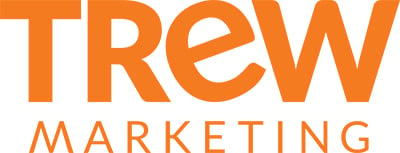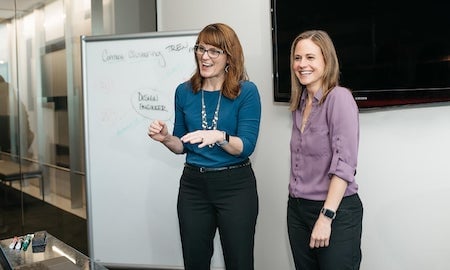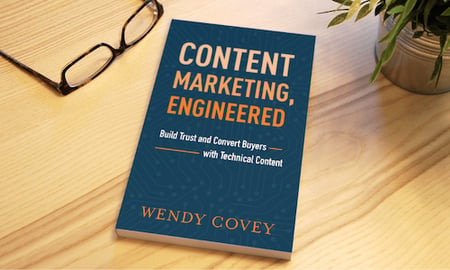What does it take to ramp up and keep up with the ever-changing world of marketing, and why does this engineer think content marketing is key to growing revenue?
"I'm just a technical guy adapting to the new reality of content marketing."
Chad Pasho, Business Development Director for Mechanical Solutions, has always had one foot in engineering and one foot in business. It was logical then that he joined a vibration testing and monitoring company to help grow revenue and delight customers.
In this role, Chad quickly grasped the importance of telling their story in a way that appealed to buyers. Persona exercises helped get this started, but ultimately deeper understanding over time and empathy provided a different frame of reference and led to more impactful messaging.
For example, MSI engineers create diagnostic videos in their work with customers, which makes for excellent marketing content when woven into a broader story connecting the customer pain and business impact, not just details of the technical problem/solution. These "moving images" and explainer videos have high video retention on LinkedIn and the MSI website.
In this episode, you'll learn about MSI's highest performing types of content and how Chad ramped up and stays current on all things content marketing.
Resources
- Mechanical Solutions website
- Chad on LinkedIn
- Writing Course: Content Writing, Engineered
- Yogund: Frozen Yogurt for Dogs
Transcript
The following transcript was created by an AI Bot which has yet to learn slang words and decipher Wendy's Texas accent. While it is no substitute for watching/listening to the episode, transcripts are handy for a quick scan. Enjoy!
Hey, everyone, and welcome to another episode of Content Marketing, Engineered. Today's guest describes himself as a technical guy adapting to the new reality of content marketing. And today, we'll hear about his journey from engineer to business development director and how he sees content marketing as a key strategy for growing revenue. He'll also talk about how he has personally ramped up on his own marketing skills. He provides a lot of specific advice on videos and case studies for all of us technical marketers out there.
And his story will be interesting for those of you who are making that swap from engineer to marketer. Let's do this.
Welcome to Content Marketing, Engineered. Your source for building trust and generating demand with technical content. Here is your host, Wendy Covey.
Hi, and welcome to Content Marketing, Engineered. On each episode, I'll break down an industry trend, challenge, or best practice in reaching technical audiences. You'll meet colleagues, friends and clients of mine who will stop by to share their stories. And I hope that you leave each episode feeling inspired and ready to take action. Before we jump in, I'd like to give a brief shout out to my agency, TREW Marketing. TREW is a full service agency located in beautiful Austin, Texas, serving highly technical companies.
For more information, visit trewmarketing.com. And now on with our podcast.
Hey Everyone. Welcome to another episode of Content Marketing Engineered. Today's guest is Chad Pasho, Director of Business Development for Mechanical Solutions. Welcome to the show, Chad.
Thanks, Wendy. It's great to be here.
I am so excited to talk to you today. And I love this quote that you sent to me when we were preparing for the show, which said that you are a technical guy adapting to the new reality of content marketing. Yeah, I think we need a little back story on your career to understand just exactly where you've come from and how you arrived at my doorstep here talking about content marketing.
OK, it's been quite a journey. I did start off as a manager, so that's what I was trained in and began my career doing formal engineering. And I got hooked up with a small company early on in my career where I had to wear many hats. And one of those was a little bit of a marketing role. So I got interested in that. Some other business things went back to school for another degree in business and then just started to get into things that were technical but still needed to do the storytelling for marketing and sales and other aspects of business development.
So I've worn a lot of different technical hats, different industries, mostly in like power generation or somewhere closely related to that. There have been some variations. So maybe in the the after story we can talk about my dog yogurt marketing career.
Oh, we're absolutely going to be talking about that today if you go that out there and just not dove in.
So, yeah, so but mostly technical. And then recently I ended up at my current company, Mechanical Solutions, where we really focus on troubleshooting for rotating machinery. So that can be a little pumps, big pumps, big turbines like power plants, big expensive, hard to solve problems. And we also started getting into a little more of the product side of that. So we actually developed some technology that required us to even rethink how we market ourselves because now we're selling a product.
So it's been a pretty fun journey. And we contacted TREW actually a couple of years ago to help us make some of those transitions and how we think about marketing and presenting ourselves and really understanding our customers and how best to match them up with what we offer.
You know, being that Mechanical Solutions works in rotating machinery, you have this very visual aspect of what you guys do and what you solve, what are some of the ways in which you've incorporated that into your content marketing strategy?
Yeah, good question. So that's one of the the benefits and the challenge is so we we often present information in a very visual format when we're doing troubleshooting or designing things. So we end up with a lot of great video content, lots of great images to tell our story. But frankly, sometimes they were getting stuck and our marketing process. So we have this video. Here, look at the video that tells you what the problem was, and we actually lacked some of the storytelling to go with that great content.
OK, in order to really help folks understand, maybe they weren't on the same diagnostic understanding level that we typically come in at. So we weren't really helping people understand how we got there and filling out that great compelling content with some of the the more mundane, I guess, storytelling which we're getting better at.
Oh, I never think of storytelling as mundane. Come on. I know that's the new coming out. I think that that no, I say that with quotes like organizationally. That's how we treated it. And I see storytelling was was less important. And we're beginning to understand you can't just give your to look at the problem I solved and that there does need to be kind of weaving that whole story together to help people empathize or help empathize with people that are in that circumstance now, kind of walk them through how we know this other person, get through that similar situation.
Right. So so the catalyst behind these videos, it sounds like it was on servicing a client. So you were already creating videos, but they were diagnostic and engineer did them. And so then you co-opted that footage, I assume, and created a different type of video for marketing purposes.
So what I'm here. Yeah. So that's probably something I should clarify when I see video. Typically we're working with animations of some analytical simulation, something like that. What counts as video in the eye candy world. But it's not like a long form video with talking heads and, you know, the roll and all those sorts of things. They're just animations that help people understand what's going on in a technical sense so that they're moving pictures for lack of a better.
Well, they're one of the stickiest parts of your website. When I think of your website, I think of those videos. So I think that that you you stumbled onto something, stumbled. You knew this. But it does such a great job of explaining what you do and what you offer. And that right prospects, I would think, looks at that video and connects with that and knows that they need your services or at least they need to dig in.
Yeah, so it's actually great on the Web site, and I will say that LinkedIn really likes videos, so they they favor those and give you just better penetration throughout LinkedIn. You get better reporting back from LinkedIn when you post video content. So even though it might be a two second video, OK, because it's just an animation and it's just looping away, we're actually able to get all that additional benefit by using that instead of a static image.
Interesting. Good, good tip there for LinkedIn. You know, that's one of the reasons why we're we're we're creating video today as part of this podcast so we can put this on LinkedIn, so.
Right.
Well, what other types of videos have you created?
So recently, we started experimenting with a longer form explainer video, so we realized some of the technical concepts that we were trying to get across for our new technology product that we were developing required more of just a long form way to explain that as like sales personnel, we found ourselves doing a lot of like handwaving and explaining, and we're doing it again and again and again. But it really wasn't something that you could do as a simple blog article either.
Like it really did require movement to the storytelling just to be able to explain some of the details behind the technology. So we we opted to go with the explainer video format just to help do that in a technical but still a compelling story kind of way. And so far, it's been very successful, like we're still just getting started with the most frequently asked questions. But that's been very helpful, not only from a sales perspective, but even from a like our genuine desire to help people understand.
We've had people come back to us and I get it. OK, thank you.
Oh, good. I was just about to say, how how do you know that it's successful? So it sounds like a lot of anecdotal feedback from people appreciating the content.
Yeah. And then just the statistics that you do get from both LinkedIn and our website just shown great video retention making making it through to the end of the video. So we're we're telling the story well enough that they want to hang on and see how it works.
Yeah, well, you've mentioned storytelling several times. So let's let's pull back bigger picture real quick. And how did you first adopt this mindset that we need to be in a storytelling mode? And what are some of the ways in which you created that story that you're now executing on in videos and other types of content?
So it was. It was a real awakening, I think, once we began to understand how content marketing was really supposed to work and it wasn't just a buzz word anymore. So once we understood it was part of that bigger story, you do need to figure out the story like what are we doing? It isn't just the list of the features and attributes that we want to push out into people's brains, but not are you sure?
Getting shorter.
I hope all the engineers out there are listening to Chad right now.
Yeah, it is. So you're once you begin to wrap your head around that, you you start to understand the customer in a more personal way. I think going through persona exercises really does help with that. But I think initially for us, it was treated as a one time exercise. So damn, now we have our persona and it's actually more than that. Like you're trying to get to know someone like your person or building. And it really takes a lot of thinking and input over time and updating that to just be able to understand where they're coming from.
And for me personally, that's really helped to understand them better, to empathize with them better. And these guys are really in a pinch. This is this is an awful place to be. How can I help quickly and effectively explain how we might be able to help them like it? Just change your your frame of reference. So switching into the story just becomes more natural once you treat it like a relationship.
And so when when you so it sounds like persona definition, but that, like you said, really adopting that persona mindset was big. And then where did you first take that story? Was it on your Solutions pages into these videos? How did you first execute on that? Or maybe it was sales material.
It was. I think it was initially. With the long was probably most active content piece, I think we we actually came into content marketing with a fair amount of content. It was just. Miss. Misreported, not misrepresented, just orally packaged, I'll say.
OK, yeah, technical content, all kinds of case studies and papers and things that we had done to tell our story in that way. But it wasn't really packaged with personas and actual people that we're trying to make decisions about how to solve the problem in mind. So getting that persona loaded in began to affect how we did our blogs. That was like our freshest content that we were doing. And then I think that probably relates to our LinkedIn as well.
I think of those as like super micro blogs a lot of time. So we're we're presenting content, but we're giving some little things in there that. Thinking through the persona actually drives our presenting that content on LinkedIn as well. Mm hmm. The blog and LinkedIn were probably our two most dynamic early places to start to apply that.
Sometimes people ask me, well, do you ever run out of ideas for new content? I said, no.
Like, I'm right. It's absolutely time. Because if you think about coverage across the buyer's journey for each of those personas and then you think about innovation and new Solutions, on top of that, there's always something new to talk about.
Oh, and as you're continuing to update it, like as you learn more about them, you're always thinking of this piece of content would be perfect for that specific aspect of who this persona is that you're getting to know.
Right. And sales involvement is so big. So I love that you have a leg on each side, you know, marketing and sales, because that's a huge source of, oh, I've just had three prospects. Asked me the same question. We need a blog about that.
That's exactly it. And I work with our sales team and get their feedback. And it does. Yeah, it's a never ending need for content.
Yeah, well, let's switch gears and talk about case studies. I know that this has been a big focus of yours lately. Why case studies and what's your approach to make sure that these have an impact?
So these studies are really important for us as a company because we sell service and it's really hard. You can't throw up your features and benefits for your service like you would with a product. And our service is kind of unique in that. It's troubleshooting, so it's not like we're going to come and wash your windows and you know that your windows are going to be cleaner than before we got there, like it's a new thing every time it's a problem.
And you don't always know what the problem is. It's why you're there. Like, if everyone knew what it was and they fix it and then what they need.
Yeah, there's this element of unknowns that we use our previous record of. Hey, here's one hundred other problems that we've solved. And chances are some of those are pretty close to what you're feeling right now. And we think that we can solve your problem, too, because that's what we do. So we use the case study to tell that part of the story where we at our our history of solving similar problems. Hopefully that helps you feel better about hiring us to solve yours.
But like I mentioned historically, that was almost purely a technical thing. So here was the problem. Here's what we did to figure it out. And then here's what we recommended that you do to fix it, period.
The story was really Mechanical Solutions coming to the rescue, but it sounds like your efforts at what you did, right?
Yeah, but even then, it wasn't like the rescue element. It was even more confined to this is the problem. This is the diagnosis and this is the solution.
I see. Yeah, the diagnosis. Yeah.
So there wasn't even the the drama behind it. So we're trying to get a lot more disciplined about. All right. Let's help understand what the real problem the customer is facing. Like, how badly does this hurt the the trouble that they're going through and that might be, you know, lost revenue per day of downtime or just having to do a lot of recurring maintenance or somebodies careers on the line because this problem just isn't getting resolved. It could be lawsuits like there are a lot of lawsuits.
And when we get involved in that, allow make some of the storytelling challenging, like we very seldom can we identify our customers, period. So it's hard to maintain that anonymity is like we have marquee customers. We have great customers that are world renowned customers. We can't talk about it because that was a really sticky situation and lawyers do what lawyers do. So do you detain the anonymity? But it's also made us shy about getting some of that back story put into the case study.
So we're trying to be more intentional about getting that back story, understanding where the customers coming from, what led up to their decision making process, where they're engaging with us, and then also helping to understand more of the happily ever after. Did they actually implement this? And how successful was it in making sure that we complete that entire story from start to finish?
So legal challenges aside, have you found that your customers are pretty willing to allow you to create a case study of your work with them provided you're following the right guidelines?
For the most part, so as long as we maintain that anonymity, most of them are fine, some of them don't even want it out there, even though it's. Anonymized, so they don't want their their images like they're the ones that I was talking about, things like that, to too hot, either legally or just competitively. So for those we we don't do case studies, obviously, but we do have a very strong word of mouth referral for situations like that one.
Yeah. So so what are some of the ways in which you are driving traffic to your content? You mentioned LinkedIn. It sounds like that's a big tool for you. So you could speak to perhaps how you're using LinkedIn and maybe other ways in which you're driving traffic.
Yeah, so LinkedIn is definitely the primary way that we drive traffic, we've put a lot of effort and investment into the LinkedIn platform. Most of that is through publishing our content to LinkedIn, and then that does pull people back to our website. So when we throw out these case studies where it does have this kind of. It's a technical who done it for engineers, so we try and set debate with, OK, here's the problem you wanted, what would you say?
Right, exactly. Oh, so it does drive traffic to our website to help people engage with that similar on the blogs that we throw out a lot of teaching type things on our our blogs and we then promote through LinkedIn. That's yeah, that's probably our biggest traffic driver. We don't do a lot with online advertising, AdWords or anything like that, we rely on the really targeted approach of LinkedIn to be able to if we want to talk to you.
And, of course, you have a very healthy organic search program going on with your blogging and videos and just your steady cadence of new content. Yeah.
OK, build out our content accordingly. I think blogs are probably the most targeted for that. Yeah, we don't really I mean, don't do our case studies with that in mind. Usually we're we're working on those other things. But the blogs, we've actually picked up some very helpful search rankings based on our blog articles.
Great. So so get him through the door, through LinkedIn and through your blogging. And then once they're there, you view your case studies. It's kind of an, you know, later in the buyer's journey if someone is considering using you or, of course, the bait, the click bait of what is all this? I love that. That's a book it makes as well as you reflect on this journey of engineer turned marketer, if you will, just what are some big lessons you've learned or advice to others in your shoes, who you are trying to make that transition as well.
I think the big lesson for me and within our organization as well, like that's kind of how I think about this, was to stop thinking about it as advertising. That was a really helpful thing to just begin to or decode content marketing, so you aren't just trying to sneak in your your product. Features and benefits, again, you really are trying to help people understand what you're about, how you can solve their problems. So that was a real big one.
Just not being afraid to do a little bit of content marketing, I think content marketing can be very scary and all encompassing like people that do it well, they do a lot of it. Well, so being able to take baby steps and get started and understand that that's OK. That was really helpful. And it's a it's a dynamic environment. So I having a teachable attitude and being able to learn what the methods are and kind of the latest and greatest cutting edge, that's been really helpful.
Uh. Yeah, those are good ones, and I like that, that you have this inquisitive nature and also you're just not afraid to try things like let's try these explainer videos or these three second when you see moving pictures. You described it moving images. So I think that that's that's worked well for you because you've seen what gains traction. And I love that in today's digital marketing world, there's so many things that can be measured. So you can get that feedback and figure out, oh, OK, I have something here.
Let me double down there and maybe, you know, divest somewhere else.
Yeah, it does help to get that feedback. I mean, everything has not been a smashing success. So we try things and there are total duds and then we don't do that again or look for maybe a different way to try it again later on. But you do start to learn what works and you are able to focus instead of just going like, oh, we should do more on LinkedIn. Like you actually begin to understand what works on LinkedIn and what does not work on LinkedIn.
And you can work accordingly.
Right. And it's not just checking some activity box. It's actually having your story right and getting your story right on LinkedIn and right.
Every time you tell it like that's part of the storytelling thing is you've got to be cohesive and every time you're putting stuff out there. Part of that overall story.
Yeah, I appreciate that that you've brought up both in this episode and talked about their relationship, because that's that's really important. it's the glue, right? Yeah. Well, where can people go to connect with you and learn more about Mechanical Solutions?
So we've talked about our website. We we have a great website where you can learn more about us that's mechsol.com as in Mechanical Solutions. And that is where we tell the majority of our story and what makes us different, and how we really are loving the Solutions part of it, not just the problem part. And then LinkedIn is where we push out all of our content as it's available. And that's just a great way where people can follow us and stay tuned into what we're doing.
And if you'd like to connect with Chad on LinkedIn, it's Chad Pasho, which is spelled p a s h o. I had to clarify on some of these interesting last names, so. Yes. Yeah. Well, Chad, thank you so much for being on the show today and sharing your content marketing journey. Really appreciate it.
Well, thank you, Wendy, and thanks for all your help on that journey as well.
Thanks for joining me today on content marketing engineered for show notes, including links to resources, visit trewmarketing.com/podcast. While there, you can subscribe to our blog and our newsletter and order a copy of my book, Content Marketing Engineered. Also, I would love your reviews on this podcast, so please, when you get a chance, subscribe and leave me a review on your favorite podcast subscription platform. Thanks and have a great day.
Wendy Covey
 Wendy Covey is a CEO, a technical marketing leader, author of Content Marketing, Engineered, one of The Wall Street Journal’s 10 Most Innovative Entrepreneurs in America, and she holds a Texas fishing record. She resides in a small Hill Country town southwest of Austin, Texas, where she enjoys outdoor adventures with her family.
Wendy Covey is a CEO, a technical marketing leader, author of Content Marketing, Engineered, one of The Wall Street Journal’s 10 Most Innovative Entrepreneurs in America, and she holds a Texas fishing record. She resides in a small Hill Country town southwest of Austin, Texas, where she enjoys outdoor adventures with her family.
About TREW Marketing
TREW Marketing is a strategy-first content marketing agency serving B2B companies that target highly technical buyers. With deep experience in the design, embedded, measurement and automation, and software industries, TREW Marketing provides branding, marketing strategy, content development, and digital marketing services to help customers efficiently and effectively achieve business goals.






 Wendy Covey
Wendy Covey

